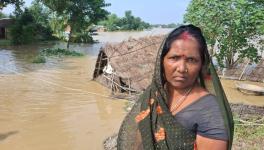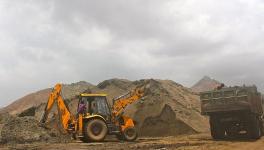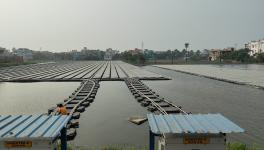How Ponds in Darbhanga Town Are Vanishing into Thin Air
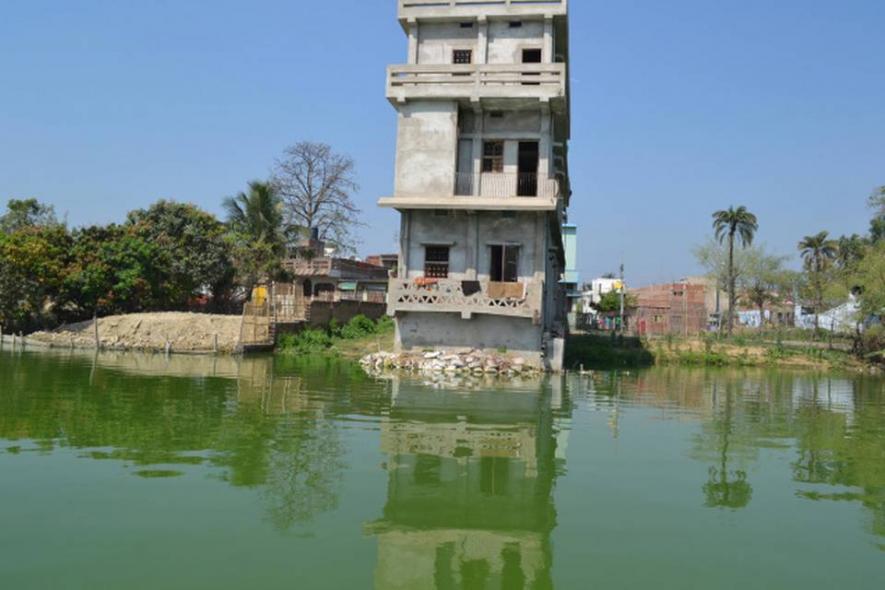
Building erected over Ganga Sagar pond. | Photo credit: Talaab Bachao Andolan
North Bihar is known for its fine network of rivers emanating from the Himalayas and also for a large number of other natural and manmade water bodies. Thousands of ponds, tanks, chaurs (land depressions) and moins (ox-bow lakes) constitute the lifeline of the region as they are a source of irrigation. But dilapidation and human encroachments are rapidly altering the existence of these water bodies and simultaneously, North Bihar, infamous for reeling under flood last year, witnessed a water crisis this year.
The name Darbhanga is derived from Duara Banga or Dar-i-Bangal, meaning the door of Bengal. This derivation, however, appears historically incorrect, as the division between Bengal and Bihar has always been much further to the East. Probably the name was derived from that of the traditional founder of the town, one Darbhangi Khan, of whom little or nothing is known.
The district is bounded on the North by Nepal, on the East by the districts of Saharsa, on the West by Muzaffarpur, on the South- east by the district of Munger, and on the South-West by the Ganga river, which divides it from Patna district.
So, what has led to the disappearance of ponds in North Bihar’s Darbhanga?
As the pride of Mithilanchal, Darbhanga is home to 50 ponds. But their vanishing streak has attained a gigantic form of concern. This land of rich history and mythology was once also known for its beauty, added by ponds and different types of water bodies. But that’s no longer the case today.
Darbhanga town has three big ponds -- Harahi, Dighi and Ganga Sagar. Once a year, the Municipal Corporation initiates steps up to clean the ponds for the Chhath festival so that devotees can take a holy dip. This done by spraying some medicine powder into the water for removing the foul smell and dirt. Ganga Sagar, Dighi and Harahi, from North to South, have a total length of 1.8 km, divided by two roads from East to West at Railway Station Chowk and Donar chowk.
Recounting various tales, Gang Singh Dev's talaab (pond) is now known as Ganga Sagar, Harahi is so called because an old skeleton was found there during excavation whereas Kunwari Diggi is still a 'kunwari' or a virgin because the sanctification ritual was never done, and so on. Sadly, the knowledge associated with the origin of these water bodies has been forgotten over time.
Vanishing Ponds
A pond in a locality, rural or urban, has multiple purposes, but these have more uses in a rural region. Besides being a constituent water body that forms a link to river, a pond also plays a social role during festival rituals, as a source of water for irrigating fields, bathing cattle and fishing. Their disappearance, therefore, indicates a dangerous sign of the eroding relationship between environment and society.
Ponds also have a rich history of religious intermingling. For example, Mirja Khan Talab in Darbhanga was built by a Muslim, but it is the Hindus who perform religious festivals there. Similarly, Harahi pond was excavated by a Hindu king, but the Muslims immerse their Taziya there.
In Bihar, the disappearance of ponds is a man-made disaster that has unfolded right under the nose of state government, which launched Jal-Jivan-Harilayi-Abhiyan to curb water scarcity statewide.
Darbhanga district has nearly 9,115 ponds and Madhubani has 10,746 ponds. Similarly, Supaul, Sitamarhi, Samastipur and other districts of North Bihar have 5,000-9,000 ponds covering an area of 1-150 acres. According to the Darbhanga district gazetteer of 1969, the town had 350 ponds and was known as the ‘City of Ponds’ but the number came down by the early 1990s.
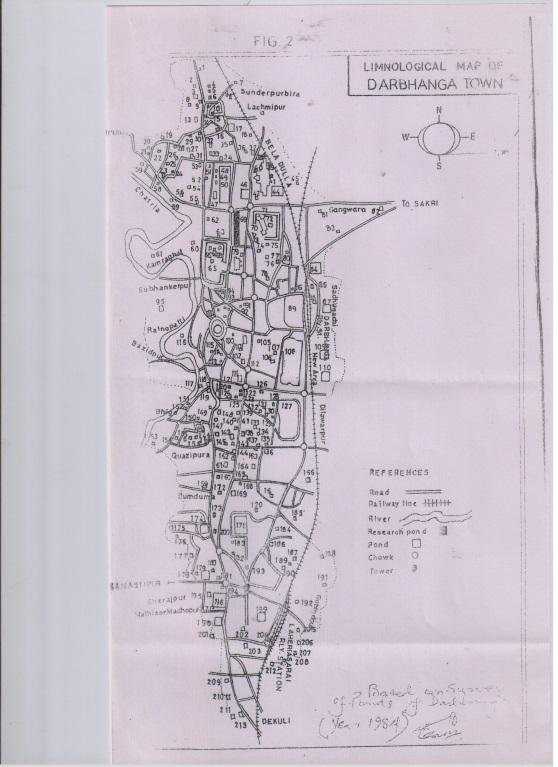
Map of ponds based in Darbhanga town by Prof. Dr. S. H. Bazmi
In 1989, research by Dr. S. H. Bazmi, Assistant Professor of Botany, Millat College, Darbhanga, noted that the town boasted 213 ponds. Today, nearly 25% of these have been drained, leveled to the ground, filled up and built over. Hotels, houses, coaching centres and high-rise buildings have bulldozed their existence.
Newsclick saw a primary school built in a congested and unsafe area towards the western side of the water bed of Dighi pond.
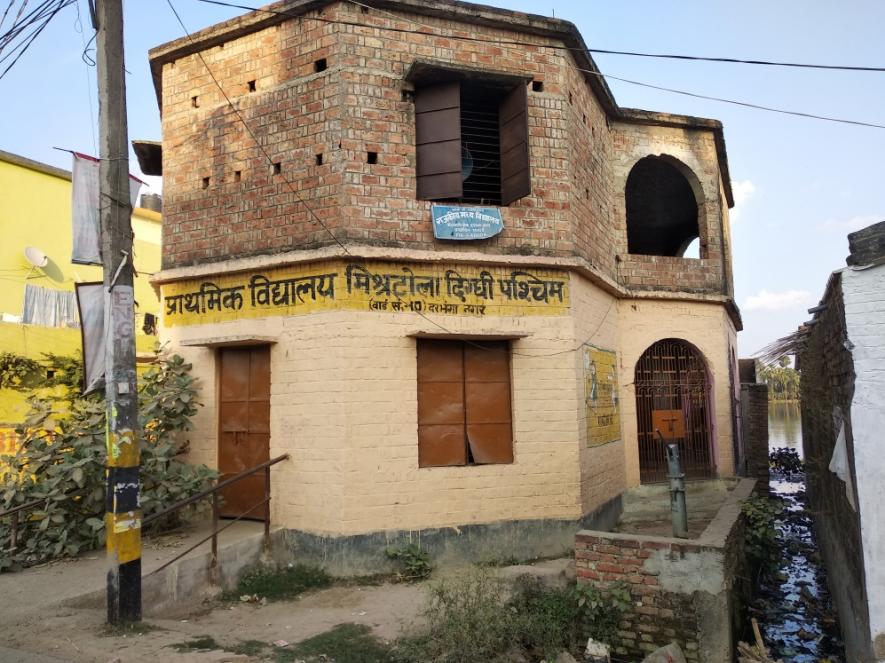
A primary school built on Dighi pond, Darbhanga town.
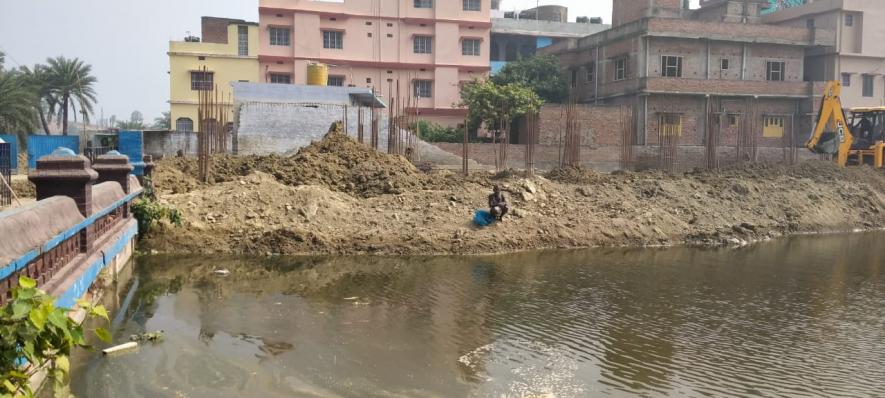
Mud-filing over Rambagh fort pond.
Likewise, a pond inside the premises of Rambagh Quila (fort) is under encroachment by a builder based in Darbhanga. Mud-filling is in full swing in broad daylight but the administration has no objection to it. On contrary, when voices have been raised, no cognizance was taken.
Approximately in 80% of area around the Ganga Sagar pond’s bank, a road has been built which has helped the land mafia to build a new colony over the pond bed by encroaching and selling the pond land.
Peoples’ Resistance
The sincerity of Darbhanga Municipal Corporation is also questionable, as these ponds have been treated as dumping ground for household waste by corporation officials. The Makhnahi pond, in particular, has a heap of waste, which saw strong protests by local residents.
The Mithila Gram Vikas Parishad, headed by Narayan Jee Choudhary, has been working for long to overcome the loss of an intrinsic relationship between humans and water bodies, such as ponds, rivers, etc. The Talab Bachao Abhiyan (TBA), a people’s initiative led by the Parishad aims to restore, protect and preserve ponds in Darbhanga, and has been opposing the illegal encroachments through protests, discussions etc.
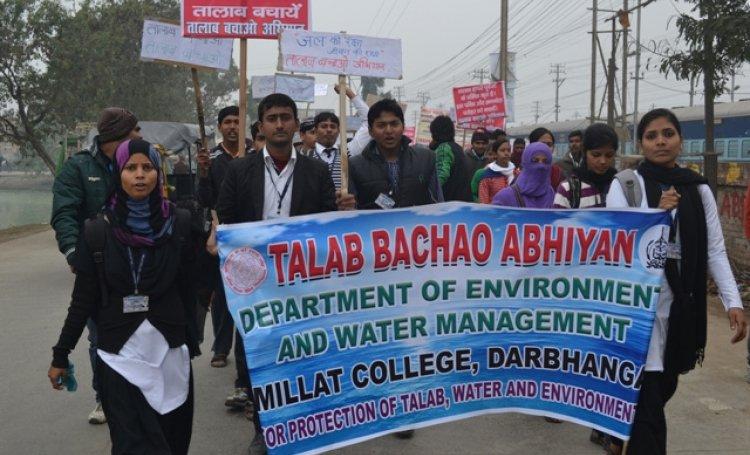
Students rally against encroachment of water bodies in Darbhanga. Pic Credit (Narayan Jee Choudhary)
While talking to Newsclick, Choudhary said: “Vanishing of ponds at an alarming rate is neither being taken seriously by the district administration nor the government. Ponds have been encroached in daylight by land-mafia and still pin drop silence prevails about this injustice to environment and also to society as whole.”
He further said that encroachment of ponds was done by government agencies, such as the primary school and panchayat bhavan, and called for a special fast trial court to punish illegal encroachers of water bodies.
“Since 2013, we have been submitting memoranda detailing the problem but no positive step has been taken,” he added.
Orders Against Pond Encroachment
In the context of encroachment of water bodies, there are no dearth of laws and regulations, but the will to enforce these is lacking.
Regarding demolition, road widening, removal of encroachment etc., in the case of Arun Kumar Mukherjee VS. State of Bihar (CWJC No. 2290 of 1996), the Patna High Court has repeatedly given orders and directions to the Bihar Government and all District Magistrates and other authorities concerned, asking for demolition and removing of encroachments from public lands, roads and flanks of the road, parks and green zones. Ironically, the pace of encroachments has doubled in places like Darbhanga.
Also, the Bihar Municipal Act 2007 highlights maintenance of pond & water bodies, pollution free pond, health & environment, safe disposal of sewage, garbage and medical waste, maintenance of greenery etc., under Section 47, Section 100, Section 185, Section 198, Section 230, Section 248, Section 249, Section 258.
But despite various orders, judgments and acts to protect and preserve water bodies like ponds, the Bihar government’s apathy is worth noticing. If unabated encroachments of water bodies continue to feed the purpose of land mafia, Bihar is not far from facing an unimaginable water scarcity.
The writer is a freelance reporter and informal researcher based in Bihar. The views are personal.
Get the latest reports & analysis with people's perspective on Protests, movements & deep analytical videos, discussions of the current affairs in your Telegram app. Subscribe to NewsClick's Telegram channel & get Real-Time updates on stories, as they get published on our website.










